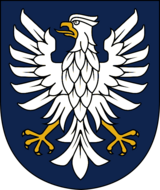National Assembly of Yavorstrana: Difference between revisions
mNo edit summary |
mNo edit summary |
||
| Line 58: | Line 58: | ||
| website = www.natsobraniye.pra.yf}} | | website = www.natsobraniye.pra.yf}} | ||
The ''' | The '''National Assembly''' is the bicameral legislature of the [[Yavorstrana|Yavorstri Federation]]. Initially conceptualized in 1867 by ministers in the government of [[Yevgeniy I of Yavorstrana|Yevgeniy I]], the Assembly initially existed as a unicameral {{wpl|The Estates|Estates}} termed the {{wpl|Zemsky Sobor}}, or ''Assembly of the Land.'' After the [[New Revolution (Yavorstrana)|New Revolution]] of 1870 and eventual reformation of the Yavorstri Dominion into its current Federal form, the State Council and Duma were formed in 1875 to coincide with the first Yavorstri elections. Its powers, enshrined in the [[Yavorstri Constitution of 1880]], serve to make it the most powerful governmental body within the Federation. | ||
The | The National Assembly comprises of two distinct bodies, each with different powers; the Duma is commonly held to be more explicitly powerful than the Council, and can override the latter in all areas except those directly pertaining to matters of the federal states and republics as denoted in the constitution. The Duma is made up of at least 386 members, and through the processes of {{wpl|Overhang seat|overhang}} and {{wpl|Leveling seat|leveling}} currently seats 414 Deputies. The Duma also maintains an electoral threshold of 4.5% in order for a party to sit candidates from its {{wpl|Closed list|closed list}}. The Council, on the other hand, has a fixed membership of 120 Councillors distributed via population and indirectly elected via the state legislatures of Yavorstrana's 14 [[Constituent States of Yavorstrana|states, republics, oblasts, and Federal Cities]]. | ||
Members of the | Members of the National Assembly meet in the [[Sokolovsky Kremlin]] in the capital of [[Yuriatin]], which was once the seat of the Yavorstri Vozhd and has served as the official {{wpl|seat of government}} for the Yavorstri Federation since 1875. The Assembly is technically led by the [[President of Yavorstrana]], though this process is only used during annual addresses to the combined bodies of the legislature and in unusual circumstances. | ||
==History== | ==History== | ||
Latest revision as of 17:47, 21 October 2019
National Assembly of Yavorstrana Национальное собрание Яворстраны Natsional'noye Sobraniye Yavorstrany | |
|---|---|
 | |
| Type | |
| Type | |
| Leadership | |
Chief Minister of the State Council | Maksim Lobanov, Democratic Union |
President of the State Duma | Yekaterina Primakova, Democratic Union |
| Structure | |
| Seats | 534 members 120 State Councillors 414 Deputies |
 | |
Political groups | Majority
Other Opposition Parties
|
 | |
Political groups | Majority Government
Other Opposition Parties
|
| Elections | |
| Mixed-member proportional representation | |
Last election | 2015 General Election |
| Meeting place | |
 | |
| Sokolovsky Kremlin | |
| Website | |
| www.natsobraniye.pra.yf | |
The National Assembly is the bicameral legislature of the Yavorstri Federation. Initially conceptualized in 1867 by ministers in the government of Yevgeniy I, the Assembly initially existed as a unicameral Estates termed the Zemsky Sobor, or Assembly of the Land. After the New Revolution of 1870 and eventual reformation of the Yavorstri Dominion into its current Federal form, the State Council and Duma were formed in 1875 to coincide with the first Yavorstri elections. Its powers, enshrined in the Yavorstri Constitution of 1880, serve to make it the most powerful governmental body within the Federation.
The National Assembly comprises of two distinct bodies, each with different powers; the Duma is commonly held to be more explicitly powerful than the Council, and can override the latter in all areas except those directly pertaining to matters of the federal states and republics as denoted in the constitution. The Duma is made up of at least 386 members, and through the processes of overhang and leveling currently seats 414 Deputies. The Duma also maintains an electoral threshold of 4.5% in order for a party to sit candidates from its closed list. The Council, on the other hand, has a fixed membership of 120 Councillors distributed via population and indirectly elected via the state legislatures of Yavorstrana's 14 states, republics, oblasts, and Federal Cities.
Members of the National Assembly meet in the Sokolovsky Kremlin in the capital of Yuriatin, which was once the seat of the Yavorstri Vozhd and has served as the official seat of government for the Yavorstri Federation since 1875. The Assembly is technically led by the President of Yavorstrana, though this process is only used during annual addresses to the combined bodies of the legislature and in unusual circumstances.
History
Components
State Council
State Duma
Role of the Prime Minister & President
Committees of the State Council
Committees of the State Duma
Departmental: Business, Innovation and Skills Select Committee
Departmental: Communities and Local Government Select Committee
Departmental: Culture, Media and Sport Select Committee
Departmental: Defence Select Committee
Departmental: Education Select Committee
Departmental: Environment, Food and Rural Affairs Select Committee
Departmental: Foreign Affairs Select Committee
Departmental: Health Select Committee
Departmental: Home Affairs Select Committee
Departmental: International Development Select Committee
Departmental: International Trade Select Committee
Departmental: Justice Select Committee
Departmental: Science and Technology Select Committee
Departmental: Transport Select Committee
Departmental: Treasury Select Committee
Departmental: Work and Pensions Select Committee
Topical: Environmental Audit Select Committee
Topical: Belisarian Scrutiny Committee
Topical: Liaison Committee
Topical: Public Accounts Select Committee
Topical: Public Administration Select Committee
Topical: Arms Export Controls Committee
Topical: Regulatory Reform Committee
Topical: Select Committee on Statutory Instruments
Topical: Women and Equalities Committee
Topical: Petitions
Internal: Administration Committee
Internal: Backbench Business Committee
Internal: Finance and Services Committee
Internal: Members' Allowances Committee
Internal: Committee on Standards
Internal: Committee of Privileges
Internal: Procedure Committee
Internal: Committee of Selection